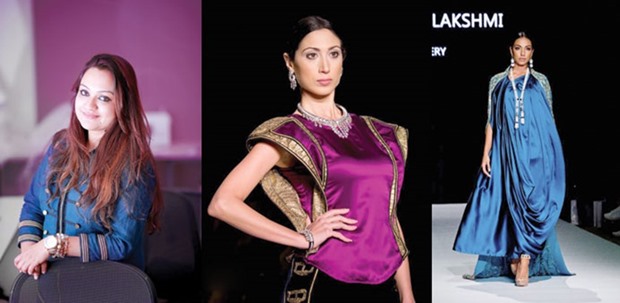It is often simple things with a degree of sentimental value that inspire her to create a design. And such designs tell stories that are printed on fabric.
The fabric itself is not just another ordinary piece of textile. It is there for a reason. Manjulakshmi Bharathan mostly works with linen and silk. Linen and silk, she also believes, are clothes with their own medical benefits.
Think Pink Wear Green (TPWG) by Gills Manjulaskhmi is not just a label for her; it is a movement and has been carefully carved out of the designer’s research. And she wants people to wear natural fabric as much as possible. Her designs are devoted to the cause.
“I found that linen long before was supported by a doctor who actually won a Nobel. He actually supported the concept that linen is a very healthy wear,” Manju, an Indian expatriate, tells Community in an interview.
The up-and-coming designer was born and brought up in Doha and launched her brand — in her name — in both India and Qatar.
“Based on that research, I followed up and found out that linen has this unique identity. So I based my ready-to-wear collection on it,” says the designer, who also teaches fashion and design at Virginia Commonwealth University-Qatar (VCUQ).
She recently launched her ready-to-wear collection Aadima for Middle Eastern women at the recently concluded Mercedes-Benz Fashion Week in Doha.
“I really want the community to wear the natural fabric. My favourite fabrics are linen and silk. Surprisingly, I found silk very easy to work with,” says Manju.
It is the use of fabric that she thinks makes her designs standout. She uses natural fabric to the maximum, save for certain draperies where it does not really work. She selects the fabric that is very unique and brings it from different countries. Manju says she does not use the same fabric that is available in the market.
Another thing that distinguishes Manju from others is cuts. Her cuts are unique and she has developed them over the years with her signature style.
The toughest part in the process of designing, she says, is finding a story to base your collection around. At VCUQ for instance, she says she teaches her students that you start with a concept and have a story in mind from where you develop a mood board. From there come the sketches and themes.
“Interestingly, for me, it has been working in the reverse order. I need inspiration to get my ideas. Once something inspires me, I start with a basic design and may be that will be my creation and from there I split it up into moods,” says Manju.
“And my inspiration would come from simple things. Sometimes when I am travelling and something clicks my mind; my Batula collection, for instance, was one of the hits of this year. The idea came from my childhood memories as I have been seeing women wearing Batula,” she explains.
It is something that is unique to the region. Women wear it after marriage and it is a traditional mark. So she thought why not bring it to design because they might not be wearing it anymore, bringing it to dresses would make it a traditional mark.
“And when I put this story into design it was very well received because people are used to seeing this and they could relate to it. During Ramadan and Eid, it was a bestseller,” says the designer.
To be a fashion designer, she thinks, you do not necessarily have to have a degree in fashion design, but of course, it helps you to be more professional. You have to have a creative mind and the ability to create something totally out-of-the-box.
In the modern world, Manju believes, it is more about marketing and understanding the market that makes a designer stand out.
“If I create, for instance, something innovative it might be accepted, but it would not necessarily be a bestseller or brand seller unless it is something that the market approves of,” she contends.
She was passionate about fashion and design since her childhood. Qatar, she says, has been a ground for designing. Everyone here loves designed clothes.
Souq Waqif was one of her favourite places where her father used to take her. Seeing costumes and textile, she got her first inspiration for designing.
Before getting into designing, Manju was a dancer into traditional Indian fare. She used to do choreography in those days and from there she started with designing costumes for dancers.
However, during the early years of graduation from school, she got into engineering and medicine, but finally left it.
“So I quit and joined a fashion design college in India as there were no universities here which would support fashion design. VCUQ came a few years later. After returning, I got appointed at VCUQ. There was no looking back,” recalls the designer.
To begin with, her clients came from local families, including affluent ones. Then, she felt she should take it a little forward and started her brand in 2013 in Qatar and India. In the beginning, it was limited only to bridal and evening dresses.
In 2014, she did her maiden international show at the annual IWED event in Qatar. It was the main opening for Manju. The following year, she launched her Henna wear, a basic Middle Eastern wear. Most of her clientele comes from Qatar and Dubai and some from America as well.

CHOICE: Manjulakshmi prefers linen and silk for her choice fabrics. Right: Manjulakshmi says her cuts have developed from years of practice; She uses only natural fabric in her designs except for draperies.
